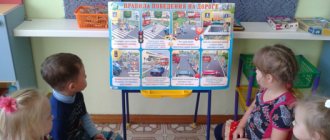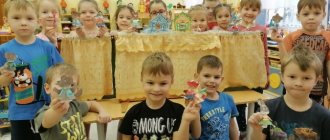Project in the senior group of kindergarten on the topic “The Magic World of Theater”
Organization of project activities for children in the senior group on the topic: “The Magic World of Theater”
Author of the project : Elena Vladimirovna Ivanova, teacher of the 1st qualification category of MBDOU “Kindergarten No. 34”, Ivanovo
Project type: creative and educational; Duration of the project: long-term (January-May) Project participants: children of the senior group, their parents, teachers, artists and employees of the Ivanovo Drama Theater. Relevance of the project: After watching a fairy tale in kindergarten, shown by artists of the Ivanovo Drama Theater, it turned out that many of the children had never been to the theater. They have no idea what it is, who works there, what it is needed for. Those children who were in the theater with their parents spoke with delight about the fairy tale they watched, but could not tell anything about the theater itself. The preschool children expressed a desire to learn more about him. This is how the idea of creating the “Magic World of Theater” project arose. Problem: Children have not developed an interest in the world of theater. Reasons: 1. Children and their families do not attend the theater or do so rarely. 2. Not enough time is spent in the family talking about the theater. 3. Lack of understanding by parents of the importance of theatrical activities for the development of the child. 4. Interest in theater is replaced by watching TV and playing computer games. Project goal: To develop an interest in theater and modern theatrical activities in children and their parents, and to develop artistic abilities in children. Objectives of the priority educational area: “Cognitive development”:
• To form children’s ideas about the theater, its types, about the people who work in the theater, about artists;
• Show the importance and necessity of each profession in the theater; • Expand children's horizons. • Develop children's interests, curiosity and cognitive motivation; Objectives of the OO in integration: “Artistic and aesthetic development”:
• Arouse interest in theater in children and parents;
• Instill in children primary skills in the field of theatrical art (use of facial expressions, gestures, voice); • Promote the development of children's creative activity. • Stimulate the development of creative, search activity, and independence of children; • Involve children and parents in joint design activities in modeling costume elements, scenery, and attributes. “Social and communicative development”:
• To arouse in children an interest in theater, a desire to participate in theatrical activities;
• To interest parents in visiting the theater with their children; • Reinforce the rules of behavior during a tour of the theater and when attending performances; • Reinforce the rules of safe behavior on the way to the theater; • Form positive relationships between children in the process of joint activities; “Speech development”:
• Activate and improve vocabulary, grammatical structure of speech, sound pronunciation, coherent speech skills, melodic-intonation side of speech, tempo, expressiveness of speech.
• Foster a culture of verbal communication, self-respect, and a conscious attitude towards one’s activities; “Physical development”:
• promote an increase in physical activity aimed at developing coordination of movements, developing gross and fine motor skills;
Expected results: 1. Children's interest in theatrical culture will expand. 2. Children’s knowledge about the history of the theater, its types, and the professions of people working in the theater will be enriched. 3. Children's creative abilities will be revealed. 4. Children's horizons will broaden and their vocabulary will be enriched. 5. Parents will become interested in visiting the theater with their children. Project products: • Creation of a subject-based environment that promotes the development of theatrical culture in children; • Theatrical performance based on the Russian folk tale “Kolobok”. Prerequisites for educational activities: personal
- the ability to evaluate one’s own activities and one’s capabilities;
communicative
- the ability to listen and answer questions, ask for help, express gratitude;
participate in joint activities; cognitive
– the ability to work according to a given algorithm;
regulatory
– the ability to carry out actions according to a model and a given rule;
the ability to listen to an adult and follow his instructions; Equipment for the teacher: laptop, camera, video camera, stereo, TV, DVD, video and audio materials, Internet. Equipment for children: different types of tabletop theaters, materials for productive activities (art activities, appliqués, modeling), themed sets and toys for role-playing games, masks, costumes, attributes for theatrical performance.
Forms and methods of project organization - Pedagogical observations. - Conversations. — Consultations for parents (individual and group). — Joint organized activities. — Registration of information for parents in the reception area. — Creative workshops (with children, with parents, individual, group). - Master classes for parents on making attributes, costumes - Theatrical activities (productions, skits) - Games - Reading fiction - Listening to audio tales - Excursion to the Ivanovo Drama Theater; — Watching outdoor performances at preschool educational institutions, performances at the Ivanovo Drama Theater.
Interaction with the families of students: 1. Help in replenishing the theater corner in the group; 2. Trips to the theater for performances with children; 3. Organization of excursions into the world of the backstage of the Ivanovo Drama Theater; 4. Joint work on the production of attributes and costumes for the theatricalization of the fairy tale “Kolobok”; 5. Advisory and educational work;
Main stages of the project: 1. Preparatory stage: Goal setting: Objectives: 1. Determine the purpose and objectives of the project, generate interest among parents in creating conditions for its implementation. 2. Study and create an information base for the project. 3. Draw up a project plan, distribute responsibilities between project participants, and arouse children’s interest in the project topic. 4. Organize parents to help carry out this project, involve them in the process of solving the assigned tasks. 2. Main stage: • Organization of work on the project: Objectives: 1. Create a developmental environment on this topic (Stimulate the development of creative, search activity, independence of children) 2. Select and make costumes, attributes for the production of a fairy tale (Create conditions for the formation of interest in theatrical art). 3. Selection of information, literature, additional material (Develop a sustainable interest in theatrical and play activities). 4. Organize a tour of the Ivanovo Drama Theater (invite parents to cooperate).
• Implementation of the project in different types of activities, taking into account the integration of educational areas: Objectives: 1. Use dramatization games during educational activities for speech development and music classes; 2. Use dramatization games when reading fiction; 3. Develop coherent speech through theatrical activities. 4. During organized labor activities, make attributes for theatrical productions. Viewing presentations
on the history of theater and theatrical costume “How the theater arose”, “History of theatrical costume” (Continue to develop a sustainable interest in theatrical and play activities)
Making attributes
, costumes, masks for theatrical activities based on the Russian folk tale “Kolobok” (Introducing children and parents to joint design activities on modeling costume elements, scenery, attributes.)
Acting out fairy tales
using various types of theater (To consolidate children’s understanding of various types of puppet theater, be able to distinguish them and name them)
Role-playing games
with children “Theater”, “ Family”, “Artists are preparing for the performance” (Expand children’s ideas about the surrounding reality)
Conversations:
“What should an actor be like?”, “Who helps actors?”, “How to behave in the theater” (Expand children’s ideas about the surrounding reality. Review the rules of behavior in the theater)
Conversation
“What are theatrical props for?”
“What is scenery?” (Planning children’s activities to create scenery, attributes for fairy tales and the role-playing game “Theater”) Conversations
with theater actors about the profession, master classes for children
Production of props
, posters, tickets for role-playing games and for the showing of the fairy tale “Kolobok” (Organization of joint activities in the form of a creative workshop)
Games based on the plots of
fairy tales and poems.
Dramatization of fairy tales (encourage the manifestation of independence and creativity in solving game situations; cultivate friendly relations between children) Dramatization games
(Form in children an emotional and imaginative perception of works through artistic description of images, develop imagination; develop emotional expressiveness of speech)
Games for the expression of emotions
, on the development of facial expressions (develop facial movements, the ability to show an emotional state through facial expressions, gestures)
Listening to audio fairy tales
performed by honored artists (Develop the ability to listen carefully to fairy tales, catch the various intonations of actors’ voices, recognize the heroes of fairy tales by ear)
Creative workshop
for making crafts based on fairy tales, drawings , applications
Excursion
to the prop room of the Ivanovo Drama Theater (Introduce children to the backstage of the theater, the professions of people working in the theater; familiarize them with the rules of behavior in public places)
Trips to the
Ivanovo Drama Theater for performances (creating interest in theatrical art)
3. Final stage: Presentation of the project Objectives: 1. Prepare for the show a theatrical performance based on the Russian folk tale “Kolobok” (Support children’s desire to actively participate in holidays and entertainment, using the skills acquired in joint and independent activities.). 2. Photo report about the theater tour, made in the form of a wall newspaper (an opportunity to share impressions and talk about what you saw). Project results: As a result of work on the project “The Magical World of Theatre”:
1. Children have developed an interest in the world of theater, theatrical and play activities. 2. Children actively and willingly participate in theatrical performances: they perform in front of parents, theater artists, and children from other groups. 3. The subject-developmental environment in the group has been updated (the theater corner has been replenished with costumes, masks, attributes, the puppet and table theaters have been updated) 4. Parents take an active part in the life of the preschool educational institution: they organize trips to the theater for performances, excursions, and participate in preparation for theatrical performances .
We recommend watching:
A project in a kindergarten for older preschoolers aged 5-7 on legal topics. A script for theatrical entertainment based on fairy tales together with parents in the younger group. A project in the older group. Theater and children DIY theater on a magnetic board for kindergarten
Similar articles:
Sketch - dramatization for children 5-6 years old
Re-enactment of the fairy tale “Turnip” for children
Sketch “Mom and Daughter” based on roles for kindergarten
Project for children of the senior group “Our cheerful garden”
Preview:
Summary of educational activities for theatrical activities in the senior group “We are actors.”
arouse interest in theatrical and play activities, create a sense of success for each individual child;
consolidate the types of theaters (drama, puppet, continue to introduce theatrical terminology (actor, director, drama theater, gapit); - introduce the theater puppet on gapit, teach basic skills of controlling a puppet;
cultivate a friendly, emotionally positive attitude towards each other;
activating children's speech through the development of dialogical speech (conversation, game, dramatization game, introduction of new words and concepts into the active vocabulary (puppeteer, gapit, actor).
Dictionary: drama theatre, puppet theatre, gapit, theatrical mask, director.
Material: screen, dolls on the gap 10 pcs. , tape recorder, audio cassettes, theatrical masks on a stick. (sad and cheerful).
(children enter the group to the music)
-Let's stand in a circle. Let's smile at each other, and so that the sun smiles at us, let's draw it with our hands: Let's draw a big circle,
Lots of rays around
This sun is shining
It illuminates everything.
“Now the room has become brighter and more joyful from our sunshine.” Now come over to the chairs, sit down comfortably, and I will tell you what we will do. Let's cancel our activity and just make small magical transformations!
- Well, do you agree? That's great!
- Guys, where do magic and wonderful transformations happen? (in a fairy tale).
- Do you like fairy tales?
— What do you like more, listening or watching fairy tales and plays?
-Where can you see them? (in the theatre) .
— Guys, are there theaters in our city?
— What theaters do you know? (dramatic, puppet)
— Guys, who shows performances, fabulous performances in the drama theater? (People)
— Do you know what these people in the theater are called? (actors)
— Actors play different roles. They can turn into anyone on stage! They can play a stupid king or a capricious princess. Or they can turn into a small helpless puppy or a cowardly bunny.
- Do you want us to try to turn into someone? Come to me, stand up wherever you want. And for a moment you and I will become actors in a drama theater, imagine that we are on stage, and here are the spectators. So, the music started playing and we were no longer kids, but kittens! The kittens got out of the warm house into the snowy yard, sniffed the cold air, and then it started snowing! Kittens don't like it! They curled up into a ball, pressing their paws, ears, and tails. But the snow stopped, the kittens straightened up, shook off their front paws, back paws, ears, tail and all their fur.
- Oh, what great fellows you are, real kittens!
- And now you are no longer kittens, but snowmen that the guys made during a walk! Snowmen love frosty days, they have fun, they smile! But then the sun began to warm up, the snowmen began to melt! First the head melted, then the arms, then the body and the snowmen turned into clean, transparent puddles.
- Well done guys, you are real actors!
- Well, now you can sit down on the chairs, relax and see what I have prepared for you. (I take out 2 masks, a happy one and a sad one)
- What is this, guys? (masks)
— That’s right, masks, but not ordinary carnival masks, but theatrical ones.
-Are they the same or different? (different)
— What mood do they convey? (happy and sad)
- Now, guys, you can come up, take any mask for yourself and we will stand in a circle.
— Look carefully at your mask, remember what mood it conveys. And we'll try on our masks
- Oh, you’re completely unrecognizable!
- Now, dear masks, you can tell what mood you are in, conveying it with your voice, and maybe even with your movement.
- Please, dear mask, tell me what kind of person you are? (I'm a happy mask)
If the mask is cheerful, it talks about it cheerfully, joyfully, cheerfully, and may even perform some funny movement!
- What about you, mask? (I'm a sad mask)
The sad mask has a sad voice, gestures and movements also express sadness. - And now all the sad masks, take a step in a circle and turn to the cheerful masks. And I invite the masks to greet each other.
— The cheerful masks will greet the sad ones first. Exciting and fun! “Hello, sad mask! ”
- And now the sad masks. Quiet and sad. “Hello, funny mask! ”
- May I greet you?
“Hello, dear masks! ” (making a mistake in intonation) - Did I convey the mood of the mask correctly in my voice?
- Why is it wrong?
- You guys are great! It was impossible to recognize you behind the masks!
They conveyed the mood of the mask wonderfully with their voice and movement! Now you can put the mask down and rest a little.
— Guys, we talked about the drama theater and even were actors ourselves, but we completely forgot about another theater, which one? (puppet)
— Guys, who is the most important person in the puppet theater?
— Does anyone help the dolls or do they perform independently on the stage or screen?
—What do you call people who are controlled by dolls?
- They are called Puppeteers! Repeat and remember this word, because today you will hear it often.
- And all because I have prepared a surprise for you!
- Today we ourselves will be puppeteers, because theatrical puppets are looking forward to seeing you in our puppet theater! Want to meet them? Then meet me!
— These dolls perform on a screen, they are called dolls on the gap.
— What is gapit? This is a stick on which the doll is put, the stick is called - GAPIT. That’s where the name comes from - dolls on gapite!
- Today I will teach you how to control these dolls, because you will be puppeteers. We take the gapit in one hand, and with the other hand we hold the wires that are attached to the doll’s hands, we can raise and lower them, the doll will come to life in your hands.






